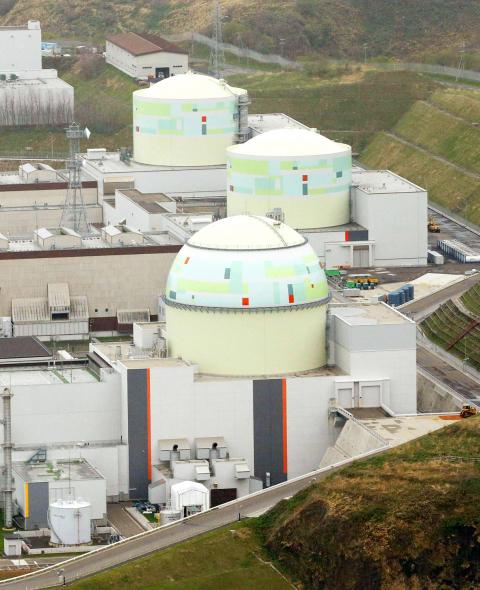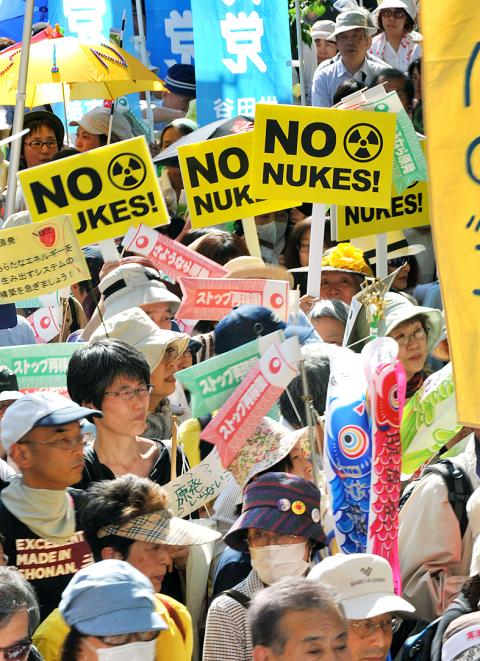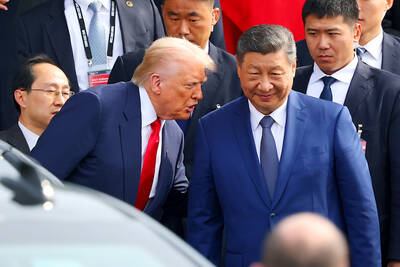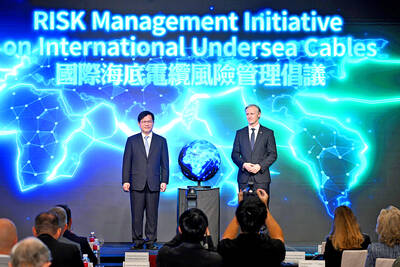A Japanese power firm began switching off the country’s last working reactor, leaving it without nuclear power just over a year after the world’s worst atomic accident in a quarter of a century.
As technicians close down the No. 3 unit at Tomari in Hokkaido, the debate over whether Japan needs nuclear power has been reignited, amid increasingly shrill warnings of summer power blackouts.
Hokkaido Electric Power, which runs the plant, said they started inserting control rods at 5pm that would halt the chain reaction and bring the reactor to “cold shutdown” sometime on Monday.

Photo: Reuters
“Power output started declining at the No. 3 unit,” said Tomohiko Shibuya, a Hokkaido Electric Power spokesman. “We have not heard of any trouble so far. Power generation there is scheduled to stop completely in about six hours.”
The shuttering will mark the first time since the 1970s that resource-poor and energy-hungry Japan has been without nuclear power, a technology that had provided a third of its electricity until meltdowns at the Fukushima Dai-ichi nuclear power plant after the earthquake and tsunami disaster in March last year.
“A new [era in] Japan with no nuclear power has begun,” said Gyoshu Otsu, a 56-year-old monk who joined a protest against nuclear power in front of the industry ministry in Tokyo which supervises the nation’s power utilities.

Photo: AFP
“Generating nuclear power is like a criminal act as a lot of people are still suffering,” said Otsu, wearing white Buddhist clothes.
“If we allow the situation as it is now, another accident will occur,” he added.
Protest organiser Masao Kimura said: “It’s a symbolic day today. Now we can prove that we will be able to live without nuclear power.”
Separately, about 5,500 demonstrators staged a rally at a park near Tokyo Tower and later marched through central Tokyo carrying banners which read: “Sayonara [Goodbye], nuclear power.”
“We have to take action now, so that Fukushima should be the last nuclear accident not only in Japan, but all over the world,” Mizuho Fukushima, head of the opposition Social Democratic Party, said during the rally.
When power generation stopped late yesterday, Japan’s entire stable of 50 reactors would be offline, despite increasingly urgent calls from the power industry and bodies like the Organisation for Economic Cooperation and Development, who fear dire consequences for the world’s third-largest economy.
Last month, Kansai Electric Power, which supplies mid-western Japan, including the commercial hubs of Osaka, Kyoto and Kobe, said a hot summer could see supply fall nearly 20 percent short of demand.
Kyushu Electric Power, covering an area further west, and Hokkaido Electric Power also said they would struggle as air conditioning gets cranked up in Japan’s sweltering summer.

UKRAINE, NVIDIA: The US leader said the subject of Russia’s war had come up ‘very strongly,’ while Jenson Huang was hoping that the conversation was good Chinese President Xi Jinping (習近平) and US President Donald Trump had differing takes following their meeting in Busan, South Korea, yesterday. Xi said that the two sides should complete follow-up work as soon as possible to deliver tangible results that would provide “peace of mind” to China, the US and the rest of the world, while Trump hailed the “great success” of the talks. The two discussed trade, including a deal to reduce tariffs slapped on China for its role in the fentanyl trade, as well as cooperation in ending the war in Ukraine, among other issues, but they did not mention

Japanese Prime Minister Sanae Takaichi yesterday lavished US President Donald Trump with praise and vows of a “golden age” of ties on his visit to Tokyo, before inking a deal with Washington aimed at securing critical minerals. Takaichi — Japan’s first female prime minister — pulled out all the stops for Trump in her opening test on the international stage and even announced that she would nominate him for a Nobel Peace Prize, the White House said. Trump has become increasingly focused on the Nobel since his return to power in January and claims to have ended several conflicts around the world,

GLOBAL PROJECT: Underseas cables ‘are the nervous system of democratic connectivity,’ which is under stress, Member of the European Parliament Rihards Kols said The government yesterday launched an initiative to promote global cooperation on improved security of undersea cables, following reported disruptions of such cables near Taiwan and around the world. The Management Initiative on International Undersea Cables aims to “bring together stakeholders, align standards, promote best practices and turn shared concerns into beneficial cooperation,” Minister of Foreign Affairs Lin Chia-lung (林佳龍) said at a seminar in Taipei. The project would be known as “RISK,” an acronym for risk mitigation, information sharing, systemic reform and knowledge building, he said at the seminar, titled “Taiwan-Europe Subsea Cable Security Cooperation Forum.” Taiwan sits at a vital junction on

LONG-HELD POSITION: Washington has repeatedly and clearly reiterated its support for Taiwan and its long-term policy, the Ministry of Foreign Affairs said US Secretary of State Marco Rubio yesterday said that Taiwan should not be concerned about being used as a bargaining chip in the ongoing US-China trade talks. “I don’t think you’re going to see some trade deal where, if what people are worried about is, we’re going to get some trade deal or we’re going to get favorable treatment on trade in exchange for walking away from Taiwan,” Rubio told reporters aboard his airplane traveling between Israel and Qatar en route to Asia. “No one is contemplating that,” Reuters quoted Rubio as saying. A US Treasury spokesman yesterday told reporters